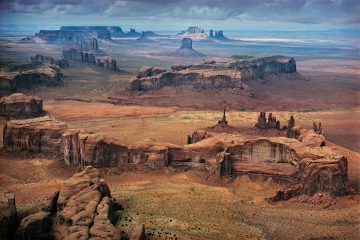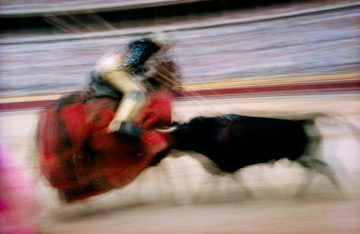Reflections on Haas
For me Ernst was sensitivity itself. He had an irresistible charm and wit, a knowledge of the world, its color, its stratis ficatious since its origin, various cultures he expressed so vividly in his photographs.He disappeared swiftly like a comet leaving behind a long trail of human understanding and with such finesse.
I can hear him bursting out laughing and making fun of me if he read this.
–Henri Cartier-Bresson, Photographer

Ernst Haas by Henri Cartier Bresson
In my estimation we have experienced an epoch in photography. Here is a free spirit, untrammeled by tradition and theory, who has gone out and found beauty unparalleled in photography. Some say it is an imitation of painting. Tommyrot! Show me a painter who can bring forth the power of this boy. Let us all stand and pay him tribute.
–Edward Steichen
The Museum of Modern Art, New York
The color in color photography has often seemed an irrelevant decorative screen between the viewer and the fact of the picture. Ernst Haas has resolved this conflict by making the color sensation itself the subject matter of his world. No photographer has worked more successfully to express the sheer physical joy of seeing.
–John Szarkowski
The Museum of Modern Art, New York
He made us see his color. when some photographers take pictures, it doesn’t matter whether they are working in black-and-white or color. But when Ernst shoots color, it makes all the difference in the world.
–Cornell Capa
International Center for Photography, New York
From letter dated October 5, 1961
Dear Ernst Haas:
I wish I could tell you how much I appreciated your color photographs which you projected at the Asilomar Conference. I have seen thousands of color pictures, most I dislike for various reasons—sheer dullness to sheer decadence! The particular quality of your work was refreshment. I hope you know what I mean. The pseudo-abstract stuff which clutters so much of the contemporary art world contributes little to the spirit. Your work—although your sources were both simple natural situations and simple “junk”—possesses a direct quality of beauty which thoroughly transcends “subject.” My congratulations! ( . . . )
I am very happy you exist. Photography is a better art because you exist. Can I say more? No! Please come out here and stay awhile with us. Again, thanks.
–Ansel Adams, Photographer

Ernst Haas, Monument Valley, Utah 1962
He’s been incredibly copied since the very beginning. The trouble is that most of Ernst’s imitators over the years have been photographically vulgar and obvious, and in a way that’s reduced his work retroactively, which is a shame. But his own eye and sense of observation are undiminished. He just does it better than all of them.
–Elliot Erwitt, Photographer
While I was attending a bullfight in Arles in the late 1950s, Pablo Picasso showed me an issue of LIFE magazine in which the famous photograph of a bullfight by Ernst Haas, at low speed and showing the movement, was reproduced. Picasso was an enthusiast and wanted me to see it because I was doing bullfights in back and white. The name Ernst Haas was already in my head. Then The Creation was published, and I was even more enthusiastic. It was after this publication that I dedicated myself more to color.
Ernst was a superb artist and a master of color. With the high level of culture and the heritage of his European roots, he was able to bring an anonymous landscape to the level of masterpiece of color and perfect opposition. No one will be able to replace a man with such a vision, a deep sense of nature, the magic of the Earth, and his relationship with the cosmos.
–Lucien Clerge, Photographer

Ernst Haas, La Suerte de Varas, Pamplona, Spain 1956
Ernst was my friend even before I met him. I had seen his color work in LIFE magazine and in a show at the Museum of Modern Art. At a time when color photography was confined to reality, Ernst was pushing at walls I didn’t even know existed. He was controlling color and breaking every rule of color photography.
Eliot Porter was also embracing the world of color, but it was Ernst who threw the gauntlet down and challenged me. The sheer beauty of what Ernst did was in the fact that he used his sensitivity to see. If there was motion, it was motion for a reason. While Minor White would see an abstract close-up of peeling paint as a surreal landscape in black and white, Ernst would shoot a piece of rag on a street and it would become a three-dimensional color vision. Ernst would never use color just for the drama of color. He used color with feeling and with reason. For me, Ernst Haas will always be the father of modern color photography.
–Pete Turner, Photographer
It is rare that the man equals the artist: Ernst did. He was the kind one listened to rather than talked to; he had so much of value to say. His work was awesome not just to me, but to an entire generation of photographers. The depth and breadth of it will emerge for years to come. I think it will be a startling revelation because he was as prolific as he was sensitive. He had a different head. It wasn’t overly crammed with photography; it was full of music, art, philosophy and history. In short, he was a rarity, a well-educated man without cynicism, in love with the world around him.
–Jay Maisel, Photographer
A writer should build sentences that are full of color and shadows. This is where painters and photographers can teach us so much. A writer can replicate the sounds of great composers or the feel of songs that move them, moving words around so that sentences bear a certain weight. So should writers look at photographs and seek to emulate the uses of light and color. Craft a sentence in the style of a photographer and see how the shapes change. Ernst Haas taught me a great deal. His use of color is extraordinary, and he once took the camera of a child—a simple Kodak model—and created a typical, brilliant photograph. It is, he said, in the eye—the creative eye—and the means by which you capture it is quite beside the point. So whatever you write—and for whomever you write it—endow it with the most truth and artistry you can.
Haas is really remarkable. If you look at his work, you start to see elements of Richard Estes and George Tooker, two other artists you should be studying.
–Tennessee Williams
Interviewed by James Grissom, New Orleans, 1982

Ernst Haas by Henri Cartier Bresson
